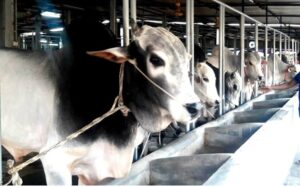The production of meat, milk, and eggs in the country has increased continuously every year for the past decade. In fiscal year 2021-22 about 131 lakh metric tons of milk about 93 metric tons of meat and 2335 million of eggs were produced in Bangladesh.
Livestock plays a crucial role in Bangladesh’s food security, balanced nutrition, and solving unemployment issues through creating self-employment, earning foreign exchange, increasing the fertility of agricultural land, and empowering women. The livestock sector’s contribution to Bangladesh’s GDP in FY 2021-22 has increased at an average rate of 5.39 percent over the last five years, according to the DLS. Although the contribution of the livestock sector to the country’s GDP is negligible, the sector has a significant contribution to meeting the country’s daily animal protein requirements. Currently, a person in Bangladesh consumes 120 grams of meat per day, which is supplied by the country’s livestock sector. Moreover, about 20 percent of the country’s population is directly, and 50 percent of the population is indirectly dependent on this sector.
In Bangladesh, the present milk, meat and egg production can meet only 50.23%, 87.23% and 63.65% of the national demand. The demand for milk, meat, egg and their products have been expanding dramatically with income growth, population growth, urbanization and dietary changes. Now it is emerging to increase the medium and high input production systems to meet the increasing demand. Presently, the number of cross bred cattle has been expanding to improve milk and meat production at both small holder and commercial level. In case of poultry, the commercial farming system has got higher growth than native chicken which is still raised under low input system. This review has tried to unearth the present scenario of livestock production systems, the distribution pattern of production systems and also the strategies for development of livestock sector in Bangladesh.
3.1 Cattle Farming;
There has been growing interest among farmers in Bangladesh at rearing and fattening bulls, encouraged by high domestic prices which enable making a profit alongside an Indian clampdown on illegal inflows of cattle.

3.2, Dairy farming:
Although, dairying is the most ancient occupation established in the rural setting of Bangladesh, its development is unsatisfactory due to several problems. The main problems concern breeding, feeding, management, diseases and marketing. The dairy sector has also not received adequate attention in respect of information and research with present policies and issues. National milk production can only meet 13% of the current milk consumption. The demand for milk is growing at a faster rate than supply because of the rapid increase in population, creating a widening imbalance between demand and supply. There is a need to have knowledge of the existing demand, its growth over time, and the existing supply possibilities. There are also many types of information needed for proper functioning of markets. In the light of such knowledge, it would be necessary to take policy measures for providing strong institutional support to increase domestic production and reduce the imbalance between supply and demand.


Hi, this is a comment.
To get started with moderating, editing, and deleting comments, please visit the Comments screen in the dashboard.
Commenter avatars come from Gravatar.